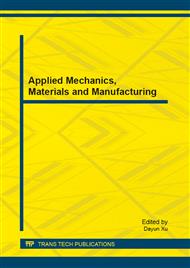[1]
Z. Ambadar, J. Schooler, and J. Cohn. Deciphering the enigmaticface: The importance of facial dynamics to interpretingsubtle facial expressions. Psychological Science, (2005).
DOI: 10.1111/j.0956-7976.2005.01548.x
Google Scholar
[2]
M. S. Bartlett, G. Littlewort, C. Lainscsek, I. Fasel, and J. Movellan. Machine learning methods for fully automatic recognition of facial expressions and facial actions. In Proc. IEEE Intl Conf. Systems, Man and Cybernetics, pages 592–597, (2004).
DOI: 10.1109/icsmc.2004.1398364
Google Scholar
[3]
J. N. Bassili. Facial motion in the perception of faces and of emotional expression. (1978).
Google Scholar
[4]
I. Cohen, A. Garg, and T. S. Huang. Emotion recognition from facial expressions using multilevel hmm. In Neural Information Processing Systems, (2000).
Google Scholar
[5]
I. Cohen, N. Sebe, L. Chen, A. Garg, and T. S. Huang. Facial expression recognition from video sequences: Temporal and static modelling. In Computer Vision and Image Understanding, pages 160–187, (2003).
DOI: 10.1016/s1077-3142(03)00081-x
Google Scholar
[6]
T. F. Cootes, G. J. Edwards, and C. J. Taylor. Active appearance models. IEEE Transactions on Pattern Analysis and Machine Intelligence, 23: 681–685, (2001).
DOI: 10.1109/34.927467
Google Scholar
[7]
A. Kanaujia and D. N. Metaxas. Recognizing facial expressions by tracking feature shapes. In International Conference on Pattern Recognition, pages 33–38, (2006).
DOI: 10.1109/icpr.2006.976
Google Scholar
[8]
J. Lafferty, A. McCallum, and F. Pereira. Conditional random fields: Probabilistic models for segmenting and labelingsequence data. In Proceedings of the 18th International Conference on Machine Learning, pages 282–289, San Fransisco, 2001. Morgan Kaufmann.
Google Scholar
[9]
P. Lucey, J. Cohn, T. Kanade, J. Saragih, Z. Ambadar, and I. Matthews. The extended cohn-kanade dataset (ck+): A complete dataset for action unit and emotion-specified expression. In CVPR4HB10, pages 94–101, (2010).
DOI: 10.1109/cvprw.2010.5543262
Google Scholar
[10]
A. McCallum. Efficiently inducing features of conditional random fields, (2003).
Google Scholar
[11]
L. -P. Morency, A. Quattoni, and T. Darrell. Latent-dynamic discriminative models for continuous gesture recognition. Computer Vision and Pattern Recognition, IEEE Computer Society Conference on, 0: 1–8, (2007).
DOI: 10.1109/cvpr.2007.383299
Google Scholar
[12]
M. Pantic and L. Rothkrantz. Automatic analysis of facial expressions: The state of the art. IEEE Transactions on Pattern Analysis and Machine Intelligence, 22(12): 1424–1445, (2000).
DOI: 10.1109/34.895976
Google Scholar
[13]
L. R. Rabiner. A tutorial on hidden markov models and selected applications in speech recognition. In Proceedings of the IEEE, pages 257–286, (1989).
DOI: 10.1109/5.18626
Google Scholar
[14]
N. Sebe, M. S. Lew, I. Cohen, Y. Sun, T. Gevers, and T. S. Huang. Authentic facial expression analysis. In IEEE International Conference on Automatic Face and Gesture Recognition, pages 517–522, (2004).
DOI: 10.1109/afgr.2004.1301585
Google Scholar
[15]
C. Shan, S. Gong, and P. W. McOwan. Facial expression recognition based on local binary patterns: A comprehensive study. Image Vision Comput., 27: 803–816, May (2009).
DOI: 10.1016/j.imavis.2008.08.005
Google Scholar
[16]
C. Sminchisescu, A. Kanaujia, Z. Li, and D. Metaxas. Conditional models for contextual human motion recognition. In In Intl Conf. on Computer Vision, pages 1808–1815, (2005).
DOI: 10.1109/iccv.2005.59
Google Scholar
[17]
M. B. Stegmann and D. D. Gomez. A brief introduction to statistical shape analysis, mar 2002. Images, annotations and data reports are placed in the enclosed zip-file.
Google Scholar
[18]
C. Sutton and A. Mccallum. Introduction to Conditional Random Fields for Relational Learning. MIT Press, (2006).
Google Scholar
[19]
Y. -L. Tian, T. Kanade, and J. Cohn. Recognizing lower face action units for facial expression analysis. In Proceedings of the 4th IEEE International Conference on Automatic Face and Gesture Recognition (FG'00), pages 484 – 490, March (2000).
DOI: 10.1109/afgr.2000.840678
Google Scholar
[20]
H. M. Wallach. Conditional random fields: An introduction. Technical Report MS-CIS-04-21, University of Pennsylvania, Philadelphia, (2004).
Google Scholar
[21]
S. B. Wang, A. Quattoni, L. philippe Morency, D. Demirdjian, and T. Darrell. Hidden conditional random fields for gesture recognition. In Computer Vision and Pattern Recognition, pages 1521–1527, (2006).
DOI: 10.1109/cvpr.2006.132
Google Scholar
[22]
G. Zhao and M. Pietikainen. Dynamic texture recognition using local binary patterns with an application to facial expressions. IEEE Transactions on Pattern Analysis and Machine Intelligence, 29: 915–928, (2007).
DOI: 10.1109/tpami.2007.1110
Google Scholar
[23]
Y. Zhu, L. C. D. Silva, and C. C. Ko. Using moment invariants and hmm in facial expression recognition. Pattern Recognition Letters, 23(1-3): 83–91, (2002).
DOI: 10.1016/s0167-8655(01)00108-8
Google Scholar


